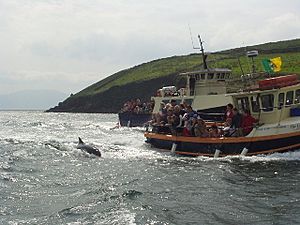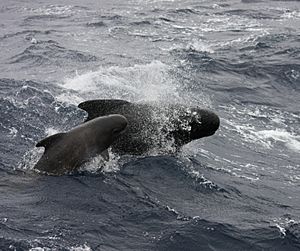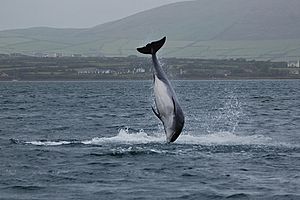Whale watching in Ireland facts for kids
Whale watching in Ireland is a super popular activity where people go to see whales and dolphins in their natural home. Since 1991, all the waters around the Republic of Ireland have been a special "Whale and Dolphin Sanctuary." This means it's a safe place for these amazing sea creatures.
Ireland's waters are home to 25 different kinds of cetaceans (that's the scientific name for whales, dolphins, and porpoises). Many of them travel past Ireland at different times of the year. Some even live there all the time in places like harbours and bays!
Contents
Why Ireland is Great for Whale Watching

A long time ago, between 1900 and 1925, there was whaling (hunting whales) off Ireland's west coast. But it stopped in 1925 because there weren't enough whales to catch. Then, in 1937, Ireland officially banned whaling with a law called the Whale Fisheries Act. After this, whale numbers started to grow again.
In 1990, a group called the Irish Whale and Dolphin Group (IWDG) was started. They are a charity that helps protect whales and dolphins. They keep track of where whales are seen and if any get stranded. They also worked hard to make Irish waters a sanctuary for these animals.
Today, whale watching is a big part of tourism in Ireland. You can watch whales from boats or even from the land! These tours often let you see seals and seabirds too, making it a fun adventure.
Top Spots to See Whales and Dolphins
You can spot whales and dolphins all along Ireland's coast. But the South coast is especially famous for whale watching. Places like County Clare, County Kerry, County Cork, and County Waterford often have sightings.
Some areas even have dolphins that live there all year round! These include Cork Harbour, the Shannon Estuary, and Dingle Bay.
Amazing Whale and Dolphin Species

There are 25 different kinds of cetaceans that have been seen in Irish waters. You can see them throughout the year, but the types of animals you spot change with the seasons.
Spring and Summer Sightings
In spring and summer, you might see many Risso's dolphins, minke whales, and even huge basking sharks. You might also spot sunfish and leatherback turtles during these warmer months.
Autumn and Winter: Big Whale Season
Locals call autumn and winter "Big Whale Season." This is when giant baleen whales arrive!
- Fin whales usually show up in late summer or early autumn.
- Humpback whales typically arrive in autumn, but they've been seen earlier in summer too.
- Sei whales are often spotted in the winter.
Year-Round Residents and Deep-Sea Visitors
Orca whales are often seen in Irish waters, but they move around a lot to follow their food. Sometimes they even come into shallow areas, like Lough Foyle or Cork city.
Some very large whales, like Blue whales, sperm whales, and long-finned pilot whales, travel through Irish waters. But they usually stay in the very deep ocean far from the coast. Scientists often find them using special underwater sound equipment or by flying planes over the ocean.
The most common animals you'll see all year are Harbour porpoises, Bottlenose dolphins, and Common dolphins. Some individual dolphins, like Fungie from Dingle, have become famous for interacting with people!
Protecting Whales and Dolphins
Ireland has special rules to keep whales and dolphins safe.
- The Whale Fisheries Act of 1937 made it illegal to hunt any cetacean in Irish waters. It also stopped Irish ships from hunting certain whales anywhere else in the world.
- In September 1991, Ireland's waters became Europe's first "Whale and Dolphin Sanctuary." This was the first time an entire country's waters were protected in this way!
- The Natural Habitat Regulations also make it against the law to deliberately bother any whale or dolphin in Irish waters. The Department of Transport, Tourism and Sport has even given boat operators rules to follow so they don't disturb these animals.


